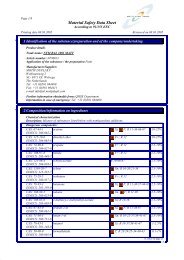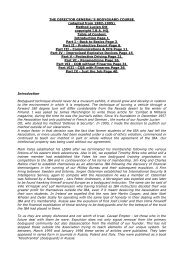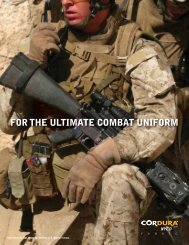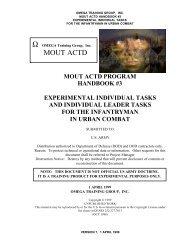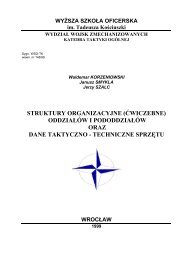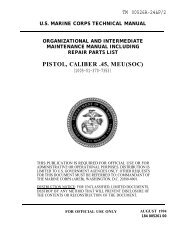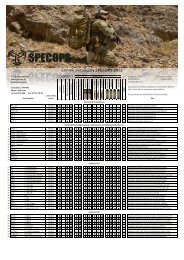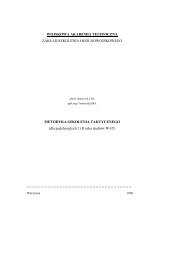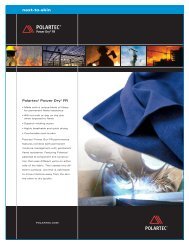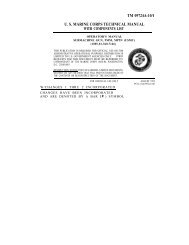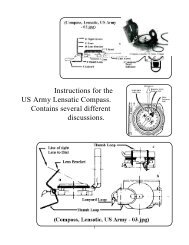mout actd program handbook #1 experimental tactics ... - SpecOps
mout actd program handbook #1 experimental tactics ... - SpecOps
mout actd program handbook #1 experimental tactics ... - SpecOps
You also want an ePaper? Increase the reach of your titles
YUMPU automatically turns print PDFs into web optimized ePapers that Google loves.
OMEGA TRAINING GROUP, INC.<br />
MOUT ACTD HANDBOOK <strong>#1</strong><br />
EXPERIMENTAL TACTICS, TECHNIQUES, AND PROCEDURES<br />
FOR THE INFANTRY RIFLE PLATOON AND SQUAD IN URBAN COMBAT<br />
_____________________________________________________________________________<br />
(1) Specially trained sniper. This specially trained and equipped individual is<br />
the most dangerous sniper. He is normally equipped with a modern scope-mounted<br />
sniper rifle. These individuals are expert shots and are trained to select key individuals<br />
as their targets. They can hit at great range (sometimes out to 1,000 meters) and are<br />
skilled in avoiding detection. They are normally members of an organized, armed force<br />
and wear a standard uniform that may be modified to provide better camouflage. Their<br />
actions are carefully integrated into the enemy's overall plan of operation. This sniper is<br />
the most difficult to counter effectively.<br />
(2) Trained marksman. The trained marksman is a common sniper often found<br />
in urban combat. This sniper is a trained soldier, equipped with a standard issue<br />
weapon, who is an above-average shot. He normally has fair to good fieldcraft skills<br />
and is difficult to detect in the urban environment. He may be employed singly or in<br />
pairs to create confusion among friendly forces, cause casualties, or harass and disrupt<br />
the tempo of operations. The enemy in an economy-of-force role or as a rear guard often<br />
uses him as a covering force while the main enemy force withdraws. He may also be<br />
placed on the perimeter of a defended urban area to provide early warning of the<br />
approach of friendly forces and to disrupt and cause them to deploy early. The trained<br />
marksman is a dangerous foe. He can be found in fairly large numbers in the armies of<br />
many potential adversaries. He is normally a member of an organized, armed force and<br />
wears a standard uniform. He may, however, be a guerrilla fighter, in which case he<br />
may not wear a recognizable uniform and may try to move among noncombatants.<br />
(3) Armed civilian irregular. The third general type of sniper is the armed<br />
irregular. He may have little or no formal military training but may have much<br />
experience in urban combat. He may or may not wear any distinguishing uniform and<br />
may even strive to appear to be merely another of the thousands of noncombatants found<br />
in a large urban area. He may or may not carry his weapon openly and may go to great<br />
lengths to avoid identification as a sniper. His fires are normally not accurate, and he<br />
seldom deliberately targets specific individuals. His actions are not normally integrated<br />
into an overall enemy plan, although his attacks may be loosely coordinated with others<br />
in his general area. Although this type of sniper has the least ability to cause heavy<br />
losses among US forces, he has high value as an element of harassment, and he may<br />
achieve results far out of proportion to his actual ability to cause casualties.<br />
g. Countersniper Tactics, Techniques, and Procedures. Countersniper TTP<br />
by US forces involves two types of actions: active countermeasures and passive<br />
countermeasures. Each has its place, depending on the METT-T conditions under<br />
which the unit is operating. Most sniper countermeasures are not new TTP for welltrained<br />
combat troops. They are simply common sense actions taken routinely while in a<br />
combat area to limit exposure to fire, conceal positions, move tactically, and respond to<br />
enemy contact. Some countermeasures are not routine, however, and require additional<br />
training emphasis. No matter which TTP are employed, successful countersniper<br />
_____________________________________________________________________________<br />
2-14<br />
VERSION 7, 1 APRIL 1999



